#writers of India
Text
The Thing Slumbering in the Depths
Ocean's Song, Part I
With each breath, its body heaved and expanded,
And with each expanse, the waters rising with it,
Making waves with greater surety than the moon.
It was immense, each breath taking a fortnight,
But the space between breaths grew shorter,
And as they grew shorter, those around took notice.
Those in the waters, who made it their home,
They were the first to notice the disturbance,
They knew not what it was, but they fled.
Though they lacked the advanced minds to think,
Every cell in their body screamed at them in unison,
To leave as soon as they possibly could.
The heaving breaths became stronger and stronger,
And the Earth beneath the Ocean began to rumble,
Shaking and quaking with every exhale.
It was the Men, intelligent creatures, who were next,
Realizing that there was a Thing slumbering in the depths,
And that it would not be asleep for much longer.

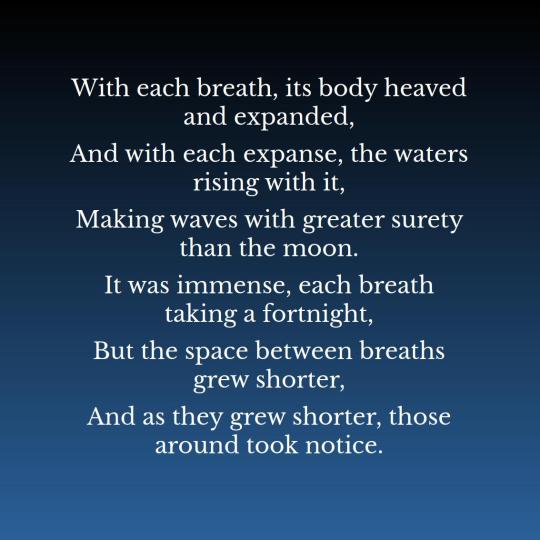


#horror poetry#horror#cosmic horror#lovecraftian#eldritch#eldritch horror#monster#creature#poetry#poem#poems on tumblr#daily poem#poems and quotes#writerblr#writers on tumblr#writers of india#kinda generic as far as cosmic horror goes in terms of concept but I hope my narrative voice makes it interesting#Ocean's Song (The Poem)
3 notes
·
View notes
Text
Grammar of Anarchy in Modern India
“...it is quite possible in a country like India – where democracy from its long disuse must be regarded as something quite new – there is danger of democracy giving place to dictatorship. It is quite possible for this newborn democracy to retain its form but give place to dictatorship in fact.” These lines are excerpted from Dr Ambedkar’s famous speech “The Grammar of Anarchy”, delivered on November 25th 1949, the eve of the adoption of the Indian Constitution. In this address, Babasaheb defined the difference between a real democracy and a facile one and laid down certain principles that he expected the future generations to adhere to, if they wished for the Indian constitutional democracy to coincide in form and in fact.
It was indeed amid much pomp and publicity that in 2015, the 125th birth anniversary of Dr Ambedkar, the current government decided to attest the tag of National Constitution Day to November 26th. It was just one of the many ways in which governments, over the years, have tried to appropriate the idea of Ambedkar for their vested interests without giving any thought to his ideals. Seen in this context, it becomes important to analyse whether today’s democratic India has lived up to the expectations of the architect of its constitution.
The first principle that Ambedkar mentioned in his speech was that in a real democracy, progress should be brought about only through constitutional methods. He sought an end to methods of Non-Cooperation and Civil Disobedience which, unless restricted, could paralyze development and saw protests as a symbol of facile democracies. Today’s India is far from realising that goal. We are a country that protests at the drop of a hat. However, more often than not, these protests, far from stifling development, have been used to coerce those in power to take the right step. Be it the 2011 anti-corruption dharnas pushing for passage of appropriate legislations or the CAA-NRC protests or the more recent anti-farm law sit-ins appealing for retraction of unpopular legislations, agitations against the ruling dispensations have been the guiding light of our democracy, seeking adherence to the constitution. So does this mean Ambedkar was wrong in his assessment of protests? No. In his speech, Babasaheb, while advocating for an end to unconstitutional protests, specifically spelled out that when there is no possibility of achieving change through constitutional means, resorting to unconstitutional methods was the only way forward. When constitutionally elected governments show apathy towards the needs or worse, go against the wishes of the very people who put them in power and constitutionally established courts and politically established opposition also leave people in the lurch, the only recourse left for the people is to mobilise and swerve those in power in the right direction. Thus, the very fact that today mass mobilisations and protests are needed to exhort governments to do what they’re elected to do, points towards the disuse and misuse of constitutional machinery.
His second prescription of eschewing the deification of leaders, is perhaps also the most pertinent advice in contemporary times. Today we have downgraded ourselves into a nation of hero-worshipping fanatics, divinizing our political leaders to the point where we fail to accept that they can ever err and ignore them when they actually do so. Living in times when being anti-Modi is routinely equated to being anti-India, Babasaheb’s warning that in politics Bhakti is a sure road to eventual dictatorship rings truer than ever.
Finally, Ambedkar in his speech, recommends us to evolve into a social democracy i.e., we mustn’t be content with the mere political sanction of liberty, equality and fraternity, but should strive to make these ideals, a way of life. Acknowledging the chasm between ‘constitutional guarantees’ and ‘social realities’, Babasaheb had famously remarked that India would, on January 26th 1950, enter into a life of contradictions where political equality would stand in contrast with socioeconomic inequalities. In calling for a social democracy, it was this gap that he sought to bridge. However, it is the sad reality of our times that, even in this aspect we have failed him. 70 more 26th Januarys have passed since that observation was made and still, we find ourselves stuck in the same quagmire. Obdurate lines of caste, class and religious inequalities have been redrawn by politically motivated leaders who find benefit in refusing to let these lines fade; Sectarian affiliations continue to override national unity, crumpling up the ideal of fraternity. And liberty, attacked by both state and non-state actors, has become a mere chimaera.
Thus, our country’s current socio-political standing is far from what the creator of our constitution had hoped it would be. It’s indeed impossible for a country as vast and diverse as ours to embody an ideal democracy, but that shouldn’t mean that we retrograde into becoming a facile democracy. Superficially celebrating the Constitution Day or Mahaparinirvan Diwas will only amount to lip service unless we reinstate adherence to these principles which add life into the soul of India’s democracy, principles prescribed by the father of the constitution himself and principles which will otherwise end up being mere quixotic embellishments for a bleak reality.
#indiralakshmi#what'sonmymind#keepingitreal#india#writers of tumblr#desi blog#law school#writers of india#constitution#indian constitution#ambedkar#jai bhim#law day#babasaheb#preamble#grammar of anarchy#speeches#famous quotes#history#independence#indian history#blogblog#indian politics#politics#indian national congress#government#prime minister#leader#life#country
11 notes
·
View notes
Text
It's not like I haven't spent time with people who are more attractive than them. I have been with more beautiful ones, ones with better political views, ones who are smarter or richer, and who are better listeners and speakers. But I don't understand how comparing people using these metrics really works. Let's say someone really was better in all these aspects - does it essentially mean I should have been in love with them instead? Do these distinctions warrant that special connection I felt with the person I "fell in love" with? Would they make us feel any more complete than them - lacking in many of these departments?
Or do we combine all their flaws and whatever few qualities they have and treat these as one? Something we crave wholly instead of dissecting each different vice and virtue - and arrive at a conclusion as to whether our feelings are worth having? It almost seems illogical, but it sure is a familiar emotion.
Well, back then, I barely had these thoughts. I started pondering such mundane things only after the chasm they left inside became too large to notice. Or maybe, I started realizing that my heart was finite after all.
#writing tags#am writing#writing blog#creative writing#writing#authors on tumblr#my writing#writers and readers#writers of india#queer writers#queer romance#queer fiction#writers#romance#unrequited feelings#instapost
3 notes
·
View notes
Text
They itch and hurt,
After everything I have tried to bury them,
they keep coming back up,
Crawling, scraping against my mind
they find a way to torment me every single time
Let them die, just like the one I shared them with.
#writers#writerscommunity#words#wordporn#death#writersclub#writers of India#memories#nightmares#dreams#forgetfulness
0 notes
Text
Me: I have a great idea! I’m going to write it down!
Me when I am in my word documents: Shoot, I need a title.
Mom: Just write the story now and write th-
Me: No, the title. Must. Be. First.
#writer things#writing#writerscommunity#writerslife#writer stuff#writer problems#women writers#fanfic writer#writeblr#writer speaks#writer of tumblr#writers of the future#writers of color#writers of the world#writers of wattpad#writers of ao3#writers of india#writersociety#writers and poets
0 notes
Text
I wasn't there to witness the glory of Treta Yuga ,
I wasn't there to witness the epic of Dvapara Yuga
But I'm fortunate enough to witness this day.
JAI JAI SHREE RAM 🚩 श्री राम 🚩
#jai shree ram#ram mandir#ram#india#indian tumblr#desi academia#desiblr#desi tumblr#txt post#txt#desi culture#writers on tumblr
205 notes
·
View notes
Text
#LongPost: A Few Hyper-Specific Things About India for India-Based Stories and Art
No this isn't a cry for more Indian-rep in Spider-Verse stories. (It is.)
Anyway. I recently went to India, and after returning to my hometown in Tamil Nadu, I reintegrated a whole slew of memories and collated new facts.. And considering I've been wanting to do one of these for quite some time (and because I need a new variety of Pavitr Prabhakar content), I thought it'd be cool if I shared some of my experiences and ideas with you.
It's best to take this with caution, though: the only places I've been to are Tiruchirappalli, Madurai, and a few towns located close to the Eastern Ghats, so my knowledge is heavily South India-based. I know for a fact that there are various similarities and differences between other geo-cultural areas of India, which is I why I've linked the other cool India Resources here as well.
In Which I Ramble About Pavitr's Character Design and the Indian Cultural Stuff Related to It by @chaos-and-sparkles (+ my addition + @neptune432's addition)
A culture post for the girlie pops (and non-girlie pops) looking to write Pavitr Prabhakar accurately by @summer-blues-stuff (+ my addition + @fandomsfeminismandme addition)
Also a timely reminder of @writingwithcolor's wonderful resources on writing about South Asian characters respectfully and sincerely
Now, for the things I've noticed in South India..
ANIMALS
There are a lot of street dogs. Like... a lot of them. And honestly it's so hard not to go up to one and give them a snack or two. The most notable dog breed is the Indian pariah and they can be found all over India. Mixed dog breeds are also common and results in a variety of features like differences in build and coat colours.


There are also other types of animals are pretty common to see alongside the roads.
Cattle are seen a lot (cows and bulls are easy to distinguish; cows (left) have udders and a small hump on their back, while bulls (right) are generally stockier and have a super-defined hump on their back). I'm pretty sure the specific cow breed is the sahiwal cow. They are either herded into paddocks for grazing or can be found wandering city streets on their own.

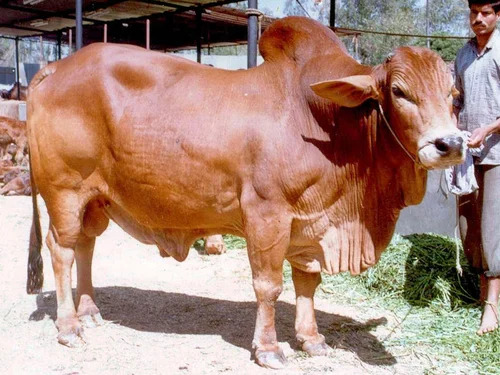
Goats are often herded by farmers into large masses of wool and horns and are guided to paddocks to graze. Sometimes, like cattle, they'll be found wandering city streets on their own.
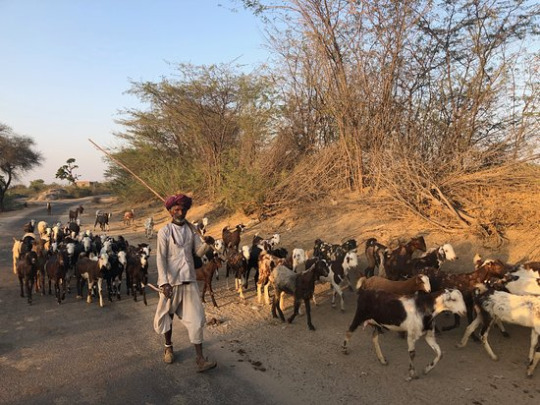
Chickens are usually kept close to stalls and homes. These chickens are not plump and fluffy like most Western chickens, but are quite skinny. Mottled feather colours are usually a result of mixed chicken breeds. In Tamil Nadu, the most common chicken breed is the asil chicken.
Various birds are often seen flying around traffic if they’re not disappearing into the sky, the most common being crows, pigeons and mynahs. (The chart below on the right is not an inexhaustive list of birds; you best search them up yourself.)
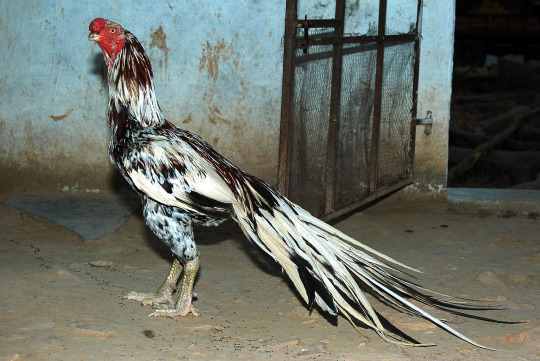

TRANSPORT
There is obviously a huge amount of trucks and lorries and buses. They all have beautiful designs or crazy LEDs or large detailed fluorescent / iridescent stickers that are impossible to ignore, whether it be at high noon or midnight.

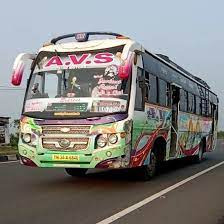
Expanding on that, the most common method of transport are motorcyclse or scooties, cars, and autos.
Also, as expected: traffic is insane. It’s horrible. It’s exhilarating. Western honking is akin to swearing, but here? Honk whenever you want. Honk if you’re happy or if you’re sad. You get a million dollars if you honk. You need to honk. It’s more important than breathing
Similarly, road rules don’t exist. Well, they do, and the Indian government does everything it can to make sure people do follow the rules, but based on the aforementioned honking, most people don't. Everyone just drives. Most bikers and motorcyclists don’t wear helmets. Only a few people wear seatbelts. Cars and motorcycles drive on the wrong side of the road and right into oncoming traffic. The chance of someone dying is 99% but it’s countered by desi stubbornness.

ENVIRONMENT & INFRASTRUCTURE
Houses and buildings are painted different colours!!! Pastel pinks and purples and deep teal hues, either plain colours or decorated with elaborate murals. This also applies to interiors. I reckon it was surprising to a lot of people when they were confronted with Mumbattan's vibrant colours, but honestly: coloured buildings slap, and it's based on the real thing. They are a sight to behold. Couple that with the architecture and oh boy- you've got such a beautiful environment.






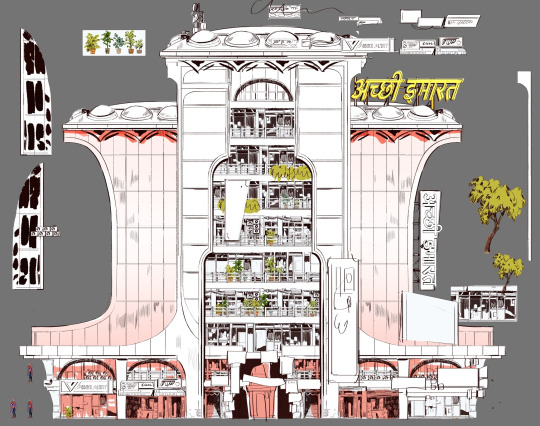
From @jettpack's concept art for Mumbattan buildings

jettpack's concept art of the Mumbattan collider
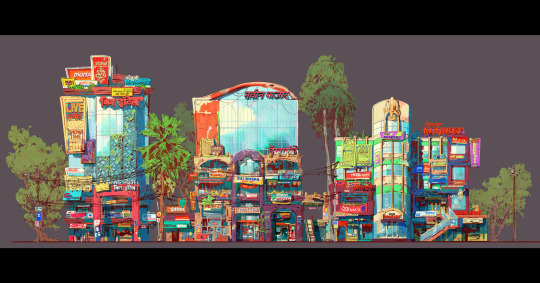
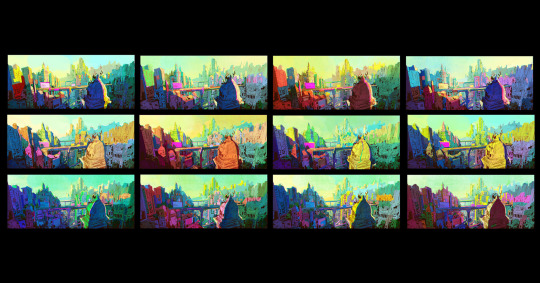
From @chenfelicia's concept and colour keys of Mumbattan
Don't be shy to really immerse in crazy descriptors - that's how you capture the liveliness of cities like Madurai and Mumbai and ultimately, their physical manifestations like Mumbattan.
Funny enough, movie posters and political banners and flyers are EVERYWHERE. They’re huge and take up entire billboards, or congregate along walls so it becomes practically a collage. It's impossible to ignore the image of "Makkal Selvan" Vijay Sethupathi about to beat some poor loser into a pulp with a stick, or the political parties roasting each other on paper with impressive photoshopped graphics.
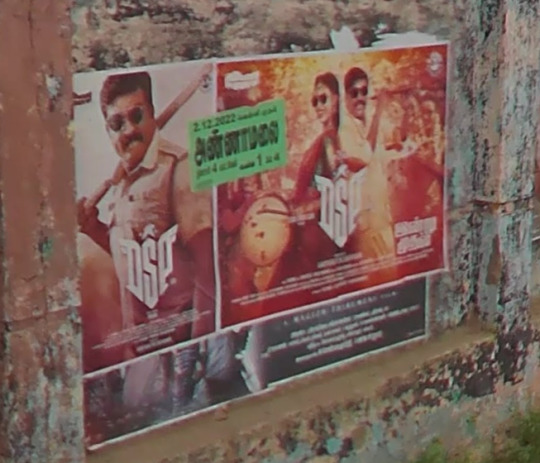

To tie in to the point about transport: there are hundreds of coffee stalls and snack shops and one-of-a-kind food stands. You can’t go 200 metres without running into one, either on the highway or in the city. I remember having jaggery coffee on my first night in India, and guys- it tasted so fucking good. I only wish I can transfer the taste to you. Absolutely splendid.
The climate in India is generally very humid and warm, but that doesn't mean we don't get cooler days; it is obviously cooler on winter nights. Also I've heard from many conflicting sources on India's seasonal weather (probably due to India's geograpghy), so you will have to talk to someone who is from India to really confirm. I've somewhat boiled it down to five seasons:
Summer - May-Jun; very hot (35-45ºC/95-113ºF), characterised by shrinking water bodies and droughts if there aren't any rainfalls; this time is good for plant growth/harvest if you've successfully managed water supplies
Monsoon - Jul-Aug; (34ºC/93ºF) very variable in terms of timing, characterised by torrential rains and floodings; the raining itself probably lodges somewhere in Jun-Sept but the aftereffects are felt long after the rains have stopped
Autumn - Sept-Nov; cooler but humid (25-35ºC/77-95ºF), and generally much drier since it transitions from autumn to winter
Winter - Dec-Feb; much colder, but the extent is dependent on geographic regions (20-25ºC/68-77ºF)
Spring - Mar-Apr; humid (33ºC/91ºF), sudden downpours, only occasionally do you get pleasant weather in this time
PEOPLE AND CULTURE
For some reason, there are still loud speakers blaring out music across the roads and as far as a few city blocks. I honestly thought that that had died out by the time my parents had graduated university, but it still seems like people like hearing music played at 120 decibels.
This is a complicated issue but people are not piss poor. Yes, India is a developing country, and yes there are slums and there are homeless and there are those who are stuck in a horrific sociocultural cycle, but people are rapidly getting into high-paying jobs at much higher rates than before. Overall, India is getting better; do us a favour and not have us be represented by the same poor struggle-riddled Indian stories that Hollywood and Western media is are fond of portraying.
@neptune432: One thing I think it's important to acknowledge though is how your experience in India changes depending on your caste. I feel like most of the indian voices talking online are savarna (I'm not an exception) so this doesn't get brought up as much. It's a complicated issue and one that I don't think non-indians (or savarna indians) should worry about tackling in their work, but it's worth saying because what's assumed to be everyday aspects of indian culture are actually specific to things like caste, class, and what region you're in.
ex: in kerala, there are also examples of people eating on banana leaf with lots of vegan food for special occasions (namely during onam). but veganism is heavily tied to brahmanism so most of these people will be savarna. even if they eat meat otherwise, the specific interest in eating vegan for special occassions has clear implications. Though many people of different castes eat meat, it's a practice that gets discriminated against, being treated as barbaric and unclean. this is because of brahmanism and is usually only strictly followed by brahmins. dalits/bahujan usually face the worse treatment for their eating traditions.
there's also the fact that hinduism is more of a recent term and a broad umbrella where many different gods and cultures have been put under (and usually done forcefully). a lot of local dieties and specific cultural practices come from outside the vedic traditions of aryans (upper caste north india), but now are treated almost as one thing. ex: kali is a south indian (dravidian) goddess who's still heavily worshipped there and who later got adapted to brahminical traditions. that's also why south indian practices of worship are different from the north and are discriminated against ex: north indians getting angry at the idea of worshipping kali by drinking alcohol and smoking even though it's an older tradition than theirs. these traditions are often connected to dalit/tribal cultures as well, which adds to why these traditions are attacked.
Now, I don't feel comfortable with non-indians writing about india in general but I feel it's important to mention these things cos most people don't even realize they're only getting shown certain perspectives. How many people don't even know they're a north/south divide, for example? People are fed narrow viewpoints on India and assume that's everything to know. it's a problem cos that's what the brahminical forces in india want. This is all very general info too and I'm no expert so it's worth more research (like reading what dalits have said on their experiences). I'm not trying to criticize you btw, I just wanted to add some things cos this has been on my mind for a long time now.
Couldn't have said it better myself, neptune!! (I barely mentioned it at all lmao) The caste system despite it being "abolished" still defines many traditions within India, and almost always in harmful ways. Like @summer-blues-stuff and I have mentioned in their post A culture post for the girlie pops under the Religion and caste section, it's best to leave the caste and social hierarchy alone even if you've done your research. That doesn't mean you shouldn't talk about it, it's just that people, especially those of non-South Asian decent, have to be extremely careful about it. Introductory resources on the caste system can be found on ABC, Pew Research and The Conversation.
Furthermore, the automatic assumption is that people living in shacks or remote villages have no access to greater populations and resources, which I'm happy to completely disprove. Guys: majority of the people living in my village, a rather remote village, have phones on them. Ranges from iPhones to Androids to good ol' Nokias.
(And, side note: as an Indian, I get amazingly pissed off when people's ringtones are set to maximum volume and play the same famous part of a famous song every time they get a call. Like shut the fuck up. At least quieten down? Please??)
(Also this might be a South Indian thing but Man some people are so entitled. Dudes you do not need to rub your ego into my face. Dudes you can, you know, keep all the cool things you think will get other people jealous out of the public eye. At this point I'm not jealous of what you Have, I'm pissed off at the Audacity To Think You Can Make Me Feel Bad About Myself With The Things That You Have).
Alright. Moving on.
Tiny temples and shrines are everywhere, dedicated to broad-Hinduism deities like Ganesh, Shakthi, or Vishnu; other times, they are shrines built for local deities that protect a particular village. For example, my village dedicated a little plot of water-logged land to a benevolent spirit called Subbamma, where people would leave offerings or place their sick/injured animals at the water's edge so that Subbamma could heal them. These tiny temples are almost always super colourful and amazingly detailed despite their small size


It could be a whole month before a celebration like Diwali but it’s the perfect time to set off hundreds of fireworks and firecrackers. People are just inconsiderate in many ways, it seems.
Some women wear strings of jasmine flowers in their hair. This might be completely regional-based, but most if not all women, ranging from little kids to old ladies, will wear these strings of jasmine in their hair. It's supposed to represent good fortune and beauty, and it smells wonderful.
@esrev-redips: #i usually only visit the north side of india (went to banglore and or chennai once) but im pretty sure most women in mumbai wouldnt wear #flowers in their hair unless they were of an older generation #they dont in new delhi at least and i t h i n k you can compare them but im not sure since i dont live in india either
Thank you esrev!!!!! glad to see an old hunch be confirmed!!!


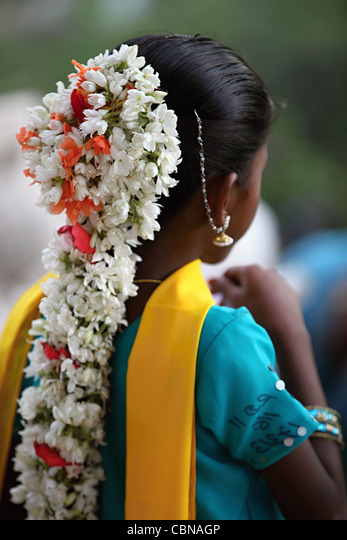
Normally you can wear any type of jasmine, but the common subtypes in Tamil Nadu are ஜாதிமல்லி (jathimalli; "Spanish jasmine"; left) and மல்லிப்பூ (mallipoo; right).


Eating food from a plate made from a banana leaf is more than just an aesthetic, and is often reserved for certain occasions; other times we eat from metal or ceramic plates. I can't vouch for other areas of India but I've been told the reason why banana leaves are predominantly used for large gatherings is because they can signal to diners if the food is rotten or has been poisoned; supposedly the leaf itself starts rotting and releases liquid, but I personally have never seen this happen. But of course, there are also other reasons as to why banana leaves are used (all of which are valid) ranging from being an eco-friendly disposable plate, offloading nutrients into food, or even to make the food taste better. Pick whichever reason you like.
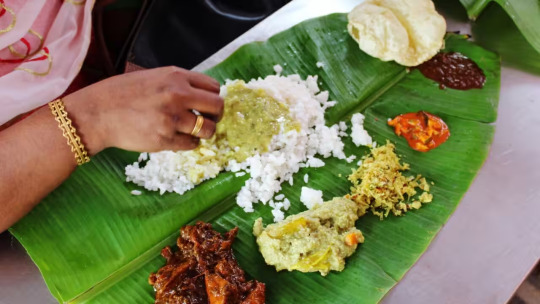
I'm literally so hungry looking at this. (Realises this is a Pavitr thing to say.) Anyway.
FOOD RECS!!!!!!
Reblog with your favourite foods >:) The list will be routinely updated...
JAGGERY COFFEE (from me) - GOOD FUCKING STUFF. ACTUALLY. if you see it.. GET IT IMMEDIATELY
PANI PURI (from @esrev-redips) - #also you forgot to mention the PANI PURI STANDS AHHHHHH YUMYUMYUM | RRRR YOU'RE SO RIGHT. PANI PURI FOR LIFE ACTUALLY.
JASUBEN PIZZA (from @the-witch-forever-lives) - okay this is specific to Ahmedabad | okay but as specific as it may be that sounds and looks delicious??? hello??????
DABELI (from @the-witch-forever-lives) - this too???? also it LOOKS wonderful i need it right now actually
VADA PAV (from @the-witch-forever-lives) - Also Vada pav from Mumbai is so one of a kind | you are absolutely correct. vada pav is truly something magnificent
I think that's about all I can give you right now. This took me a while to type out. Feel free to ask any questions, or if you have anything you would like to add on, like anything I might have glossed over or your favourite desi foods, please do!!! I'll be sure to reblog your addition and update the original post.
The point is that this post can become one of those few other reference posts that artists and writers and other creatives can use if they ever want to make anything related to India, because it's genuinely so cool to see your culture represented so well in popular modern media.
(And in fanfic and fandom. Especially in fanfic and fandom. you have no idea how many times I've gone insane reading a Pavitr-centric fic or reading comments on Pavitr-related posts and it's just outdated ideas and harmful stereotypes and all sorts of sick bullshit, and it's always to the point where I physically have to go outside and bite into a fresh rhizome in order to ground myself. Like damn, people, you need to know things before you start creating)
So uh, I hope this was helpful if not interesting! Happy early Diwali everyone! Knowledge-over-ignorance and all that; hopefully this post does that notion justice!
#pavitr prabhakar#wrote this solely because i wanted more atsv pavitr-centric fics and i need to get that specific immersed-in-india itch scratched#and also because the india i remembered decades ago is definitely not the india i visited last week#wow time flies doesn't it#spider man india#india#writing tips#o wise writer stuff#indian culture#south asian culture#spider man across the spider verse#atsv#across the spider verse#chaipunk#goldenpunk#cultural references#atsv pavitr#agnirambles
207 notes
·
View notes
Text


India Song (Marguerite Duras, 1975).
#marguerite duras#India song#delphine seyrig#france#classic movies#lana del rey#vintage#film stills#film photography#classic film#cinema#aesrhetic#writer#movie quotes#quotes#madness
328 notes
·
View notes
Text
Okay but imagine you're not a main character in the Oxford friend group.
You love Felix because everyone loves Felix, but you're not in love with him, not in any way that matters, not like everyone else. He is the sun which you all revolve around, but you know too well he's the kind to burn you. Instead you've spent two years pinning after the pretty girl with the dark hair and the bright laughter. And she loves Felix. The same way everyone else loves Felix. The same way every other girl you've tried to invest yourself in has ended up loving Felix fucking Catton when they end up, even briefly, integrated in your friend group.
So India is your best friend, and the girl you quietly love, and she complains to you about Felix's various trysts, and how Oliver looks at him (without any of her own self awareness) and all you can think about is how she glitters and glows in the light. How Felix could live a thousand lifetimes and not deserve the love the world gives him. The love your best friend gives him.
She cries on your shoulder, and eggs you on to ask that cute girl in your art history class to a gallery, and you wonder if she knows how badly she's stringing you along with the drunken kisses and that one time you slept together and you thought you heard her moaning someone else's name. But you keep coming back.
When Felix finally starts showing up to the pub with your best friend on his arm, it's the most excited you've seen her in a long time. She doesn't talk about Annabel, you wonder if she even misses her. You miss Annabel. Or maybe you missed when Felix was looking at her and not India.
Summer comes and India can't help but complain about Oliver Quick getting an invite to Saltburn, until his birthday comes around and it means an invite to Saltburn for both of you. An invite to Felix.
India looks like a dream at that party, but not one you're allowed to have.
In the wake of what happens, you're the shoulder she cries on again, the receptacle for her grief. There is no sun for her anymore, only you, loyal, the one who's spent years mooning over her. You both grieve for Felix; under your jealousy he was still your friend.
"I love you," India cries, "please don't leave me too."
And you wonder how many other people have to live knowing they came second to a ghost.
#saltburn imagine#saltburn x reader#felix catton x reader#felix catton imagine#india saltburn#india saltburn x reader#i just think shes very pretty at Ollie's party and this hit me#manic writer
98 notes
·
View notes
Text
When Maulana Tariq Jameel said;
“Zameen tumhara kuch nahi bigaar sakti agar tumhara asmaan se taaluq mazboot ho.”
I felt that !
#maulana#tariqjameel#connection#allahswt#urdu#quotes#islamicreminders#islamicquotes#life quotes#urdu lines#urdu adab#urdu poetry#urdu stuff#fav#deep quotes#deep writing#lit#aesthetics#pakistan#india#urdu language#urdu literature#powerful#spilled emotions#spilled truth#writer and poets#muslim supremacy#muslimquotes#poems and poetry#daily reminder
78 notes
·
View notes
Text
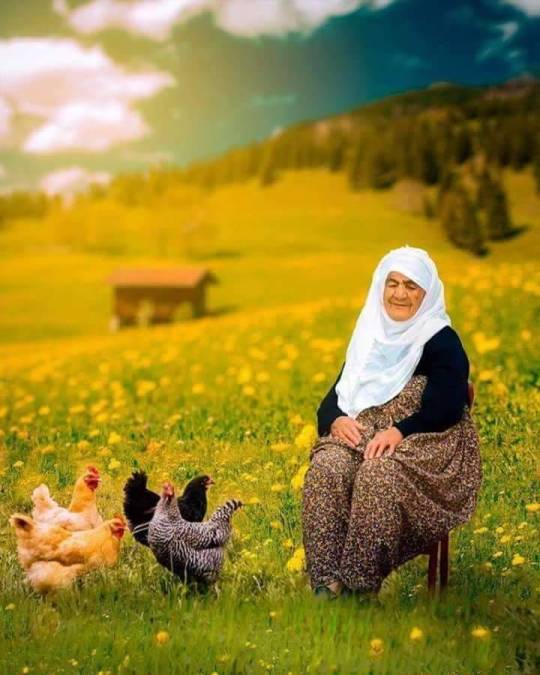

Hayat bazen çok güzel bir fotoğraf karesidir..🌸
Sometimes life is a beautiful photograph..🌸
#art#cute#home & lifestyle#writers#postlarım#my post#photography#nature#design#artists on tumblr#naturecore#paradise#adventure time#cottagecore#explore#traveling#india#style#photographers on tumblr#vintage#retro#pretty#inspiration
138 notes
·
View notes
Text
The Battle of Belonging
"Howmuchever I did not want to belong in Mysuru, it was still my own. It was and will forever be a part of me, mine. I can only escape from it geographically, but it will forever and till eternity, remain in my heart, as an indelible, inescapable part of my identity and personality."
Caveat: The following blog piece is a deeply personal and reflective essay. Read only if you have the mental capacity to handle the trauma dumping.
NRIs have this thing called ABCD, it stands for American-born confused Desi. This pithy phrase very succinctly captures the confusion and the identity crisis that they experience, being a vibrant cultural minority in a foreign land.
I am not an NRI. Nor am I in foreign lands. and yet, I am going through a somewhat similar experience. This feeling of not belonging here and not wanting to belong there. The constant conflict in the mind. The two different worlds which you know will never meet - like the two shores of the sea. The eviscerating feeling of not knowing who I am, where my heart lies, what I identify as, how I should react to situations and events... constantly trying to reconcile the two ends of the spectrum. The two feelings, the two yous, the two behaviours, the difference, the split, conflict, confusion. Who am i? Who is prerana?
Am I the silent, serious, career-oriented, driven, focused, straight-talking Prerana who always rebelled against her parents, teachers, friends and family, who always tried to push the boundaries and who was very sagacious and calm and mature and wanted to reach for the stars and leave mysuru behind, escape from the small-minded people and their parochial thoughts and outdated ideas... or should I qualify those attributes with a "supposedly" or "assumed"? Supposedly small-minded people; assumed parochial thoughts and outdated ideas. Supposed and assumed by me. The girl who always looked at the skies hoping to escape into the calm familiarity of its darkness, looking for a stairway out of the small town. Grasping for opportunities...
Or am I the Prerna who is excited to learn new things, the empathetic listener, always down for a chat, available for a call, hugging people, trying to belong, wanting to belong? Trying to firmly establish herself on the ground, to grasp at the grass trying to find her footing, the one who is accepting of every new culture, tradition and way of life, the one who is trying to wiggle in rather than escape out? trying to be here, now. embracing, condoning and accepting this place for what it is- warts, wounds, wonders and all. jostling in with the people and accepting and celebrating them for who they are, their thoughts, ideas, small-mindedness, and narrow thinking?
I hated that place because of what it is, and now I am trying to fall in love with this place despite what it is. And yet, I seem to have forgotten to realise that, in the heart of hearts, overarchingly, both mysuru and Jindal are the same. They may be different cultures, but the small-minded ideas remain, the narrow thoughts and othering of what doesn't fit in with the established norm remains.
That was a community-oriented life and I struggled to create a space for myself. This is an individual-oriented space and I am fighting to create a community of my own. But why?
I grew up in Mysuru, a mysuru that was in the perpetual shadow of the Bengaluru. Every single holiday I would get, we would catch the first train to Bengaluru. leaving mysuru and its lethargy and laziness behind. The joy of seeing the suburban Bengaluru slums from the window of my train seat, which heralded the arrival in the city, a city which I since forever wanted to make my own. And a city I always looked at with glinting eyes and gaping mouth. The city which had my heart, my love, my life.
The yearning for that big city, that cosmopolitan culture, that melting pot of ideas, cultures, traditions, that urban, chic, jet black and grey ad white world with tall towers and big cars and traffic-jammed streets. the endless opportunities. the vibrant nightlife. the food, the street, the big corporate hubs, the cafes buzzing with people; forever, the breweries and the sense of not being judged for sipping a drink or wearing a torn jean or hanging out with English-speaking boys.
The peacock from mysuru zoo wisting to dance under the pale blue-grey hues and occasional showers of the Bengaluru sky.
I was never happy in mysuru. Never satisfied with the city. Never got myself to like it. Those ceremonial debates about mysuru v. Bengaluru, I always took the side of Bengaluru. Not that mysuru didn't have opportunities or wasn't modern or anything... But i tried to steer clear of the modern mysuru. Tried to stay put and ply my game on the path out of the city. Like I didn't want to get distracted or enticed by whatever little wonders mysuru had to offer.
Now, I have come to Jindal. Achieved what I wanted. Reached where I thought I wanted to. Escaped, finally and successfully. And after a long drawn, draining and desiccating fight no less. That rebel in me has won the final fight. The ultimate rebellion. I wanted to leave, but they held me back, they pulled me back, they tied and tethered me back but I broke free, suffered through bruises, and endured their glare, stare and spit. Roared, screamed, and unleashed myself. and now I have left. That fight has now reached its conclusion. There's no reason to feel restless. That goal that always lingered around and directed my every step and action has been fulfilled. Years of penance, struggle, and rebellion have finally borne fruit. I have reached where I wanted to. I have done it ma. I have gotten my way. I have won against you, appa, those aunties and uncles who constantly questioned me, those people from college who tried to pull me down. I have won the battle against all of you guys... I have stayed put, my obstinacy and stubbornness have reached their end now. I got what I wanted. This is what I had prayed, starved, begged, kicked, fought and screamed for. This is it. The cosmopolitan, urban lifestyle is finally mine. Mine to live.
But.
But there is still a battle to be fought. yet another one. another fight to fight. my mind tells me to live another day. Fight this one last battle and we will see what happens tomorrow. One more fight, one more struggle, one more battle, one more. But this is a different battle. If my first fight was a Tapasya to escape, to not settle, to not remain, to leave and get out of the suffocation. This is a fight to belong. to feel like I belong, to fit in, to forget about the sky and hold on to the ground. to touch the grass, and the mud and make it my own. the battle of belonging. To settle down. to remain even if it means suffocating myself. to keep my mind open and to take in every new idea, every new experience, new feeling and culture and tradition and people. But if this is what I wanted all my life and this is what I fought for all my life, why am I continuing to fight even after having gotten what I have wanted? what is it that I seek? Why is there another struggle? I wanted this, right? More than want, I yearned for this. And now that I have it, why does the restlessness remain?
What do I do about this constant conflictual state of mind? That's a futile question to ask, to be fair to myself. Conflict, much like change is a constant. There is no escaping from conflict. sometimes it is the external conflict, sometimes it is the inner conflict. but conflict remains. And when there is none, the mind makes one. The mind is a very weird thing. It does not want to settle. It does not want to be satisfied. It wants more and more and more and better and higher. There is always a battle to be fought. Live another day, sleep another night - quite literally these days.
Then, what is the problem? if I am aware of this peculiarity of the mind, if I have always been fighting fights and waging wars, internal as well as external, shouldn't I have gotten used to them by now? Shouldn't I have gotten adjusted to the hustle now? What is it that is making me take a step back and pause to reassess everything?
I always thought of leaving mysuru as the first step to independence and freedom. Leave mysuru first and then leave India next. Explore the world, wear down those peripatetic feet, and satiate that ever-hungry mind. So having escaped mysuru, I should have, by now, embarked on my next fight. the fight for emancipation from the manacles that fate imposed on me when it made me an Indian. all of this, I had mapped out and planned out in my mind. But in my eagerness, I failed to anticipate the intermediate level. Between the fight for escaping from mysuru, where I had been born and the fight to escape into the larger world, where i wanted to live, there was this one intermediate level. I left mysuru and reached Delhi, reached Jindal. Now, I have to leave Jindal and reach new york? London? sydney? tokyo? or just the road leading up to the Supreme Court of India? But before I commence on that journey, there is one more goal to achieve. And that is to make Delhi and Jindal mine and my own. to belong here, to fight to be one among these people, to embrace them and their culture. Because, if I do not make this my own, what will I fight against when I begin my battle to move out of India? I have to first own this before I can rebel. i have to first be here before I can leave from here. I failed to anticipate that belonging here could be an entire battle in itself. But it should not be a battle... I shouldn't have to fight for anything that is already, rightfully, mine... do I? I should not have to fight to belong here. Nor should I have had to fight to leave from there. But it is what it is. The battle of belonging. and I have to make peace with it.
yours,
I.L.
youtube
#blogblog#blogger#india#leaving#small town#mysuru#jindal#desi blog#india bloggers#writers of india#writers of tumblr#keepingitreal#life#what'sonmymind#indiralakshmi#Law school#gen z thoughts#coming of age#Youtube
5 notes
·
View notes
Text
I had always considered home as a concept of safety and contentment. I know that not many people may say the same about their homes, but fortunately, whenever things went south, I felt like I would have a space to fall back into, reset, and come back at least slightly recovered.
Around the time I started "adulting" I seldom had to stay at home for extended periods. And that was also when I slowly started learning more about myself and became aware of all the issues I have to deal with. When I stayed long enough in my home and got too accustomed to it, I realized that it might not be an environment conducive to healing and growth.
External factors aside, the notion of me alone inside my room, left to myself with nothing other than my unwholesome thoughts would have seemed manageable. But that's not how things go when you let your guard down a little too much and you become unmindful of all the boundaries and walls you had built around yourself.
It feels almost like being suffocated by something which is supposed to keep you alive. To feel the burn inside that globe of comfort with nobody there to hear the cries of pain and distress - because the space is always supposed to be THE safe zone.
On top of it, there is a lot of holding back as the associated guilt keeps building up inside - guilt about being ungrateful, guilt about not taking advantage of whatever I have right now, guilt about bemoaning my circumstances while leading a cozy day-to-day routine, etc.
And honestly, I can't be certain whether escaping this panic room is what will ultimately bring me any iota of peace. Hell, I don't even know if peace is what I need to fix this conundrum I find myself in daily.
And it's especially hard to choose when the available alternatives are either suffocating to death or getting torn apart.
#authors on tumblr#my writing#queer writers#writers#writing tags#writing blog#creative writing#writing#writers and readers#writers of india#depression#anxiety#mental health
1 note
·
View note
Text
I have seen death more times than I would care to remember. I stared at its face as he loomed over my brother. I watched as he sat at the foot of my grandmother's bed. I looked him in the eye as he followed my grandfather. Each time I begged him to have mercy. To leave them alone. This was the first time that I gazed upon him and felt his embrace hoping he would take me with him.
1 note
·
View note
Text
#india love#nico mirallegro#the wilds#yesung#amy lee#walt disney#skateboard#writers block#dead#bohemian rhapsody
123 notes
·
View notes
Text
#clouds#Armond Rizzo#india love#nico mirallegro#the wilds#yesung#amy lee#punk girl#skateboard#writers block
121 notes
·
View notes